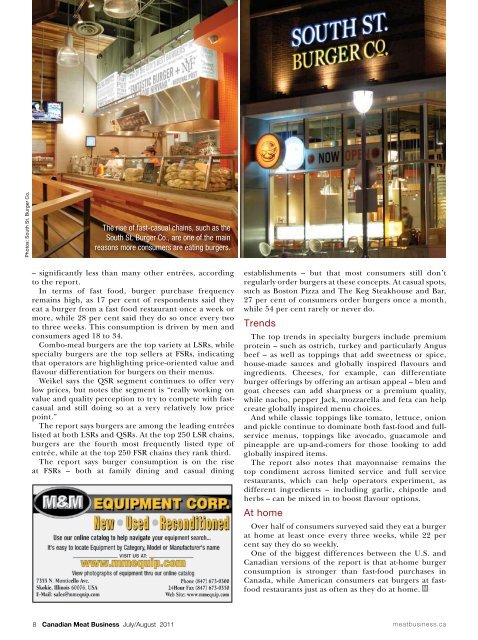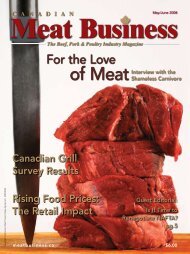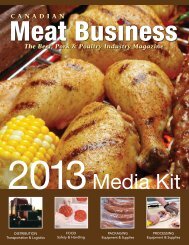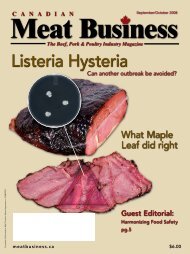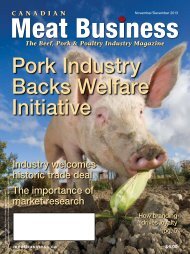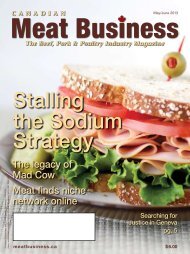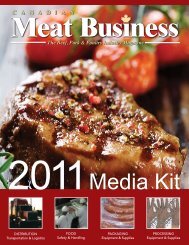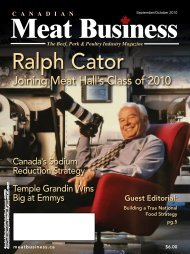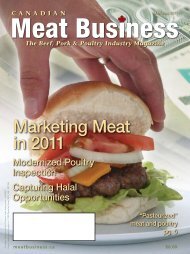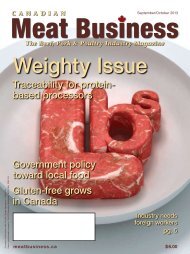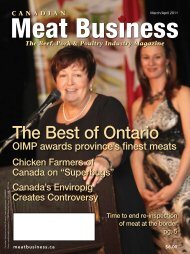Consumption on the Rise
Source - Canadian Meat Business
Source - Canadian Meat Business
- No tags were found...
Create successful ePaper yourself
Turn your PDF publications into a flip-book with our unique Google optimized e-Paper software.
Photos: South St. Burger Co.<br />
The rise of fast-casual chains, such as <strong>the</strong><br />
South St. Burger Co., are <strong>on</strong>e of <strong>the</strong> main<br />
reas<strong>on</strong>s more c<strong>on</strong>sumers are eating burgers.<br />
– significantly less than many o<strong>the</strong>r entrées, according<br />
to <strong>the</strong> report.<br />
In terms of fast food, burger purchase frequency<br />
remains high, as 17 per cent of resp<strong>on</strong>dents said <strong>the</strong>y<br />
eat a burger from a fast food restaurant <strong>on</strong>ce a week or<br />
more, while 28 per cent said <strong>the</strong>y do so <strong>on</strong>ce every two<br />
to three weeks. This c<strong>on</strong>sumpti<strong>on</strong> is driven by men and<br />
c<strong>on</strong>sumers aged 18 to 34.<br />
Combo-meal burgers are <strong>the</strong> top variety at LSRs, while<br />
specialty burgers are <strong>the</strong> top sellers at FSRs, indicating<br />
that operators are highlighting price-oriented value and<br />
flavour differentiati<strong>on</strong> for burgers <strong>on</strong> <strong>the</strong>ir menus.<br />
Weikel says <strong>the</strong> QSR segment c<strong>on</strong>tinues to offer very<br />
low prices, but notes <strong>the</strong> segment is “really working <strong>on</strong><br />
value and quality percepti<strong>on</strong> to try to compete with fastcasual<br />
and still doing so at a very relatively low price<br />
point.”<br />
The report says burgers are am<strong>on</strong>g <strong>the</strong> leading entrées<br />
listed at both LSRs and QSRs. At <strong>the</strong> top 250 LSR chains,<br />
burgers are <strong>the</strong> fourth most frequently listed type of<br />
entrée, while at <strong>the</strong> top 250 FSR chains <strong>the</strong>y rank third.<br />
The report says burger c<strong>on</strong>sumpti<strong>on</strong> is <strong>on</strong> <strong>the</strong> rise<br />
at FSRs – both at family dining and casual dining<br />
establishments – but that most c<strong>on</strong>sumers still d<strong>on</strong>’t<br />
regularly order burgers at <strong>the</strong>se c<strong>on</strong>cepts. At casual spots,<br />
such as Bost<strong>on</strong> Pizza and The Keg Steakhouse and Bar,<br />
27 per cent of c<strong>on</strong>sumers order burgers <strong>on</strong>ce a m<strong>on</strong>th,<br />
while 54 per cent rarely or never do.<br />
Trends<br />
The top trends in specialty burgers include premium<br />
protein – such as ostrich, turkey and particularly Angus<br />
beef – as well as toppings that add sweetness or spice,<br />
house-made sauces and globally inspired flavours and<br />
ingredients. Cheeses, for example, can differentiate<br />
burger offerings by offering an artisan appeal – bleu and<br />
goat cheeses can add sharpness or a premium quality,<br />
while nacho, pepper Jack, mozzarella and feta can help<br />
create globally inspired menu choices.<br />
And while classic toppings like tomato, lettuce, <strong>on</strong>i<strong>on</strong><br />
and pickle c<strong>on</strong>tinue to dominate both fast-food and fullservice<br />
menus, toppings like avocado, guacamole and<br />
pineapple are up-and-comers for those looking to add<br />
globally inspired items.<br />
The report also notes that may<strong>on</strong>naise remains <strong>the</strong><br />
top c<strong>on</strong>diment across limited service and full service<br />
restaurants, which can help operators experiment, as<br />
different ingredients – including garlic, chipotle and<br />
herbs – can be mixed in to boost flavour opti<strong>on</strong>s.<br />
At home<br />
Over half of c<strong>on</strong>sumers surveyed said <strong>the</strong>y eat a burger<br />
at home at least <strong>on</strong>ce every three weeks, while 22 per<br />
cent say <strong>the</strong>y do so weekly.<br />
One of <strong>the</strong> biggest differences between <strong>the</strong> U.S. and<br />
Canadian versi<strong>on</strong>s of <strong>the</strong> report is that at-home burger<br />
c<strong>on</strong>sumpti<strong>on</strong> is str<strong>on</strong>ger than fast-food purchases in<br />
Canada, while American c<strong>on</strong>sumers eat burgers at fastfood<br />
restaurants just as often as <strong>the</strong>y do at home.<br />
Canadian Meat Business July/August 2011<br />
meatbusiness.ca


